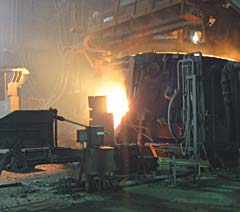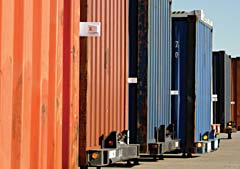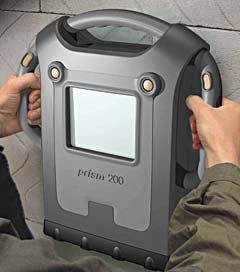Keeping Things Cool
 For steel makers, controlling the production process is vital to maintaining the quality of the material, the health of the equipment, and the safety of the workers. Anything that causes an unplanned shutdown takes a bite out of the bottom line, a definite drawback in the competitive world of steel production.
For steel makers, controlling the production process is vital to maintaining the quality of the material, the health of the equipment, and the safety of the workers. Anything that causes an unplanned shutdown takes a bite out of the bottom line, a definite drawback in the competitive world of steel production.Electrical current frequently arcs to the sides of steel furnaces, and sometimes this can superheat the furnace wall. If the superheating is severe enough, it overloads the temperature cooling system. Should the cooling system fail completely, the molten steel will burn through the furnace walls in a matter of minutes, spewing on to the shop floor, putting the workers at risk, damaging equipment, and causing the whole shebang to grind to a very expensive halt.
Monitoring the temperature in the water jackets around the furnaces is hard on the sensors used (even during cool periods the temperature at the sensor site measures >125°C), but with 24/7 production, there’s very little time to install or replace them. One major steel manufacturer decided to go wireless, installing a series of RTD nodes from Sensicast between the inner and outer furnace walls. Because the nodes use the company’s SensiNet intelligent mesh networking technology, they can establish reliable communications even in the presence of strong magnetic and electrical fields and large amounts of metal. Since the nodes are wireless and self-configuring, installation is as easy as turning on the node.
Contact Peter Stein, Sensicast Systems, Inc., Needham, MA; 781-453-2555, [email protected].
Where, Oh Where, Has My Trailer Gone?
 How do you find a particular tractor-trailer and track its movements when it’s somewhere within a 60 acre facility full of other trailers? That’s the problem American Port Services (APS) had at its cross-docking facility in Savannah, GA, operated by APS on behalf of one of the world’s largest retailers. To solve this perplexing problem, AGI Worldwide, a supply-chain consulting organization, surveyed the current technology and chose AeroScout to provide real-time location services for APS.
How do you find a particular tractor-trailer and track its movements when it’s somewhere within a 60 acre facility full of other trailers? That’s the problem American Port Services (APS) had at its cross-docking facility in Savannah, GA, operated by APS on behalf of one of the world’s largest retailers. To solve this perplexing problem, AGI Worldwide, a supply-chain consulting organization, surveyed the current technology and chose AeroScout to provide real-time location services for APS.AeroScout’s Visibility System combines WiFi and RFID to track assets in real time. Each trailer entering the facility is fitted with a WiFi-based active RFID tag. As the trailer moves through the yard, the tag’s location is tracked in relation to Location Receivers placed throughout the area to be monitored. The resulting location and content data are integrated with existing yard management systems.
According to Ty Cobler, director of operations at APS, “The AeroScout system is an outstanding solution to a pressing problem in the logistics and transportation industry, and automates a manual trailer-tracking process that used to take a full team of people and hours every day.”
Contact Josh Slobin, AeroScout, Inc., San Mateo, CA; 650-571-0800, [email protected].
Seeing Through Walls?
 What would you say if I told you that you could see through walls without using x-rays? No, it isn’t science fiction, it’s a novel use of ultra-wideband (UWB) radar. Cambridge Consultants, a Cambridge, U.K.-based R&D company with its U.S. headquarters in Boston, has created a stand-alone handheld radar unit that passes low-frequency UWB radar pulses through walls and provides images of internal activity within 2 s. Aimed at the urban security, military, and emergency search and rescue market, the device can detect minor movements and display them on its built-in 6.4 in. color display.
What would you say if I told you that you could see through walls without using x-rays? No, it isn’t science fiction, it’s a novel use of ultra-wideband (UWB) radar. Cambridge Consultants, a Cambridge, U.K.-based R&D company with its U.S. headquarters in Boston, has created a stand-alone handheld radar unit that passes low-frequency UWB radar pulses through walls and provides images of internal activity within 2 s. Aimed at the urban security, military, and emergency search and rescue market, the device can detect minor movements and display them on its built-in 6.4 in. color display.
Based on the company’s Prism 100 radar, the new Prism 200 version can pass UWB pulses through building materials >40 cm thick to detect activity over a range of up to 15 m. The radar core uses an array of antennas to give a field of vision (FOV) of up to 140° horizontally and vertically as well as enabling 3D object location and motion tracking. The 3D capability allows the operator to tell whether people are standing, sitting, or lying, allowing him or her to decide who is a threat and who is a victim (or whether it’s a human or a dog). Don’t expect photorealistic images, however; each individual shows up as a cluster of same-color targets allowing the operator to follow that person’s movement through the monitored area. Another neat trick? You can use a tracking history of individuals to build up a picture of the room layout.
Contact Andrew Diston, Cambridge Consultants, Boston, MA; 978-685-3136, [email protected].